Features
Terry Gobanga: 'I was gang-raped on my wedding day'
When Terry Gobanga - then Terry Apudo - didn't show up to her wedding, nobody could have guessed that she had been abducted, raped and left for dead by the roadside. It was the first of two tragedies to hit the young Nairobi pastor in quick succession. But she is a survivor.
It was going to be a very big wedding. I was a pastor, so all our church members were coming, as well as all our relatives. My fiance, Harry, and I were very excited - we were getting married in All Saints Cathedral in Nairobi and I had rented a beautiful dress.
But the night before the wedding I realised that I had some of Harry's clothes, including his cravat. He couldn't show up without a tie, so a friend who had stayed the night offered to take it to him first thing in the morning. We got up at dawn and I walked her to the bus station.
As I was making my way back home, I walked past a guy sitting on the bonnet of a car - suddenly he grabbed me from behind and dumped me in the back seat. There were two more men inside, and they drove off. It all happened in a fraction of a second.
A piece of cloth was stuffed in my mouth. I was kicking and hitting out and trying to scream. When I managed to push the gag out, I screamed: "It's my wedding day!" That was when I got the first blow. One of the men told me to "co-operate or you will die".
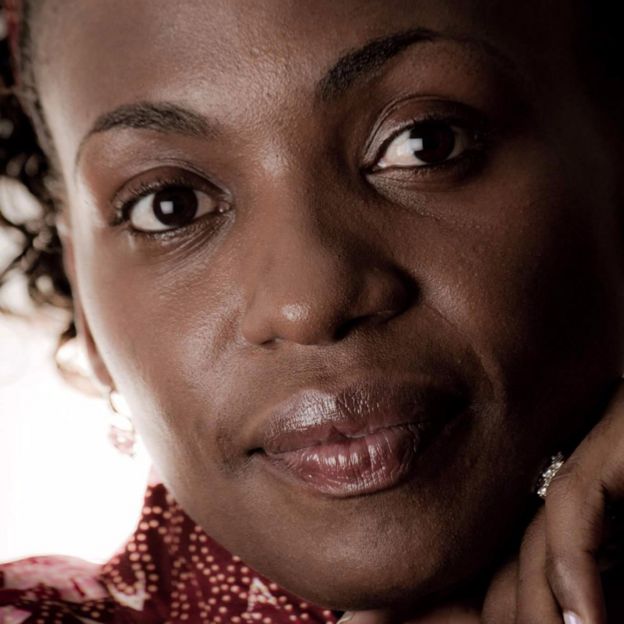 TERRY GOBANGA
TERRY GOBANGA
 TERRY GOBANGA
TERRY GOBANGA
The men took turns to rape me. I felt sure I was going to die, but I was still fighting for my life, so when one of the men took the gag out of my mouth I bit his manhood. He screamed in pain and one of them stabbed me in the stomach. Then they opened the door and threw me out of the moving car.
I was miles from home, outside Nairobi. More than six hours had passed since I had been abducted.
A child saw me being thrown out and called her grandmother. People came running. When the police came they tried to get a pulse, but no-one could. Thinking I was dead, they wrapped me in a blanket and started to take me to the mortuary. But on the way there, I choked on the blanket and coughed. The policeman said: "She's alive?" And he turned the car around and drove me to the biggest government hospital in Kenya.
I arrived in great shock, murmuring incoherently. I was half-naked and covered in blood, and my face was swollen from being punched. But something must have alerted the matron, because she guessed I was a bride. "Let's go around the churches to see if they're missing a bride," she told the nurses.
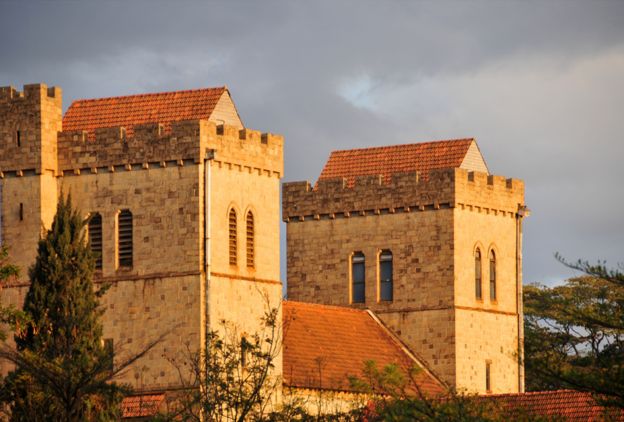 |
| *All Saint's Cathedral is the oldest Anglican cathedral in Nairobi GETTY IMAGES |
By coincidence, the first church they called at was All Saints Cathedral. "Are you missing a bride?" the nurse asked.
The minister said: "Yes, there was a wedding at 10 o'clock and she didn't come."
When I didn't show up to the church, my parents were panicking. People were sent out to search for me. Rumours flew. Some wondered: "Did she change her mind?" Others said: "No, it's so unlike her, what happened?"
After a few hours, they had to take down the decorations to make room for the next ceremony. Harry had been put in the vestry to wait.
When they heard where I was, my parents came to the hospital with the whole entourage. Harry was actually carrying my wedding gown. But the media had also got wind of the story so there were reporters too.
I was moved to another hospital where I'd have more privacy. That was where the doctors stitched me up and gave me some devastating news: "The stab wound went deep into your womb, so you won't be able to carry any children."
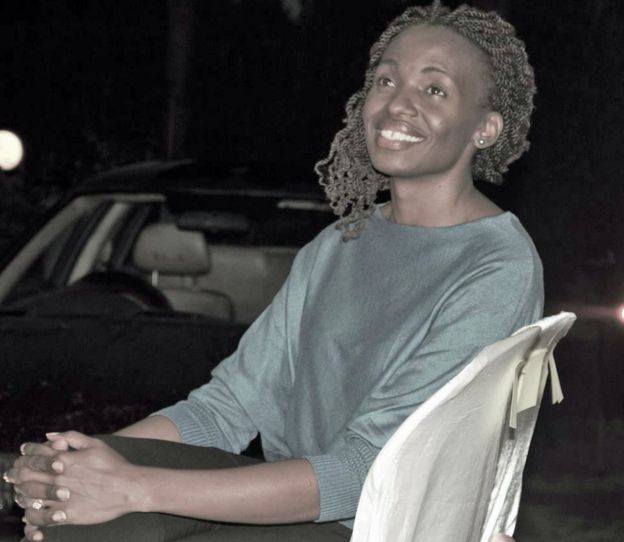 TERRY GOBANGA
TERRY GOBANGA
 TERRY GOBANGA
TERRY GOBANGA
I was given the morning-after pill, as well as antiretroviral drugs to protect me from HIV and Aids. My mind shut down, it refused to accept what had happened.
Harry kept saying he still wanted to marry me. "I want to take care of her and make sure she comes back to good health in my arms, in our house," he said. Truth be told, I wasn't in a position to say Yes or No because my mind was so jammed with the faces of the three men, and with everything that had happened.
A few days later, when I was less sedated, I was able to look him in the eye. I kept saying sorry. I felt like I had let him down. Some people said it was my own fault for leaving the house in the morning. It was really hurtful, but my family and Harry supported me.
The police never caught the rapists. I went to line-up after line-up but I didn't recognise any of the men, and it hurt me each time I went. It set back my recovery - it was 10 steps forward, 20 back. In the end I went back to the police station and said: "You know what, I'm done. I just want to leave it."
Three months after the attack I was told I was HIV-negative and got really excited, but they told me I had to wait three more months to be sure. Still, Harry and I began to plan our second wedding.
Although I had been very angry at the press intrusion, somebody read my story and asked to meet me. Her name was Vip Ogolla, and she was also a rape survivor. We spoke, and she told me she and her friends wanted to give me a free wedding. "Go wild, have whatever you want," she said.
I was ecstatic. I went for a different type of cake, much more expensive. Instead of a rented gown, now I could have one that was totally mine.
In July 2005, seven months after our first planned wedding, Harry and I got married and went on a honeymoon.
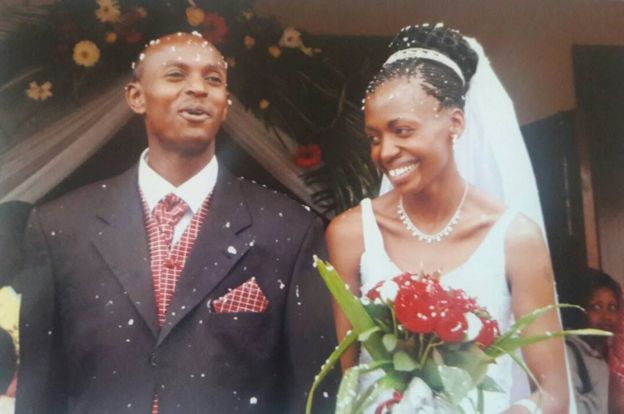 |
| *Harry Olwande and Terry on their wedding day in July 2005 TERRY GOBANGA |
Twenty-nine days later, we were at home on a very cold night. Harry lit a charcoal burner and took it to the bedroom. After dinner, he removed it because the room was really warm. I got under the covers as he locked up the house. When he came to bed he said he was feeling dizzy, but we thought nothing of it.
It was so cold we couldn't sleep, so I suggested getting another duvet. But Harry said he couldn't get it as he didn't have enough strength. Strangely, I couldn't stand up either. We realised something was very wrong. He passed out. I passed out. I remember coming to. I would call him. At times he would respond, at other times he wouldn't. I pushed myself out of bed and threw up, which gave me some strength. I started crawling to the phone. I called my neighbour and said: "Something is wrong, Harry is not responding."
She came over immediately but it took me ages to crawl to the front door to let her in as I kept passing out. I saw an avalanche of people coming in, screaming. And I passed out again.
I woke up in hospital and asked where my husband was. They said they were working on him in the next room. I said: "I'm a pastor, I've seen quite a lot in my life, I need you to be very straight with me." The doctor looked at me and said: "I'm sorry, your husband did not make it."
I couldn't believe it.
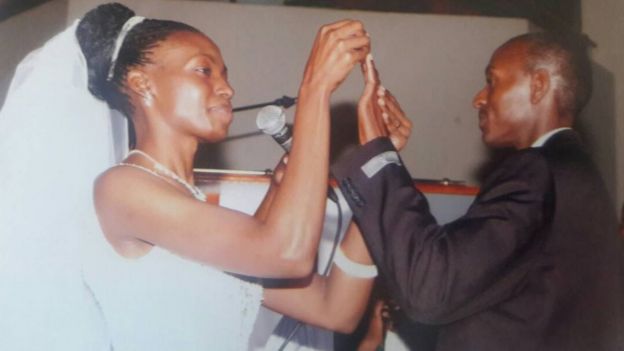 |
| *Terry places a ring on Harry's finger TERRY GOBANGA |
Going back to church for the funeral was terrible. Just a month earlier I had been there in my white dress, with Harry standing at the front looking handsome in his suit. Now, I was in black and he was being wheeled in, in a casket.
People thought I was cursed and held back their children from me. "There's a bad omen hanging over her," they said. At one point, I actually believed it myself.
Others accused me of killing my husband. That really got me down - I was grieving.
The post-mortem showed what really happened: as the carbon monoxide filled his system, he started choking and suffocated.
I had a terrible breakdown. I felt let down by God, I felt let down by everybody. I couldn't believe that people could be laughing, going out and just going about life. I crashed.
One day I was sitting on the balcony looking at the birds chirping away and I said: "God, how can you take care of the birds and not me?" In that instant I remembered there are 24 hours a day - sitting in depression with your curtains closed, no-one's going to give you back those 24 hours. Before you know, it's a week, a month, a year wasted away. That was a tough reality.
I told everybody I would never ever get married again. God took my husband, and the thought of ever going through such a loss again was too much. It's something I wouldn't wish on anybody. The pain is so intense, you feel it in your nails.
But there was one man - Tonny Gobanga - who kept visiting. He would encourage me to talk about my husband and think about the good times. One time he didn't call for three days and I was so angry. That's when it hit me that I had fallen for him.
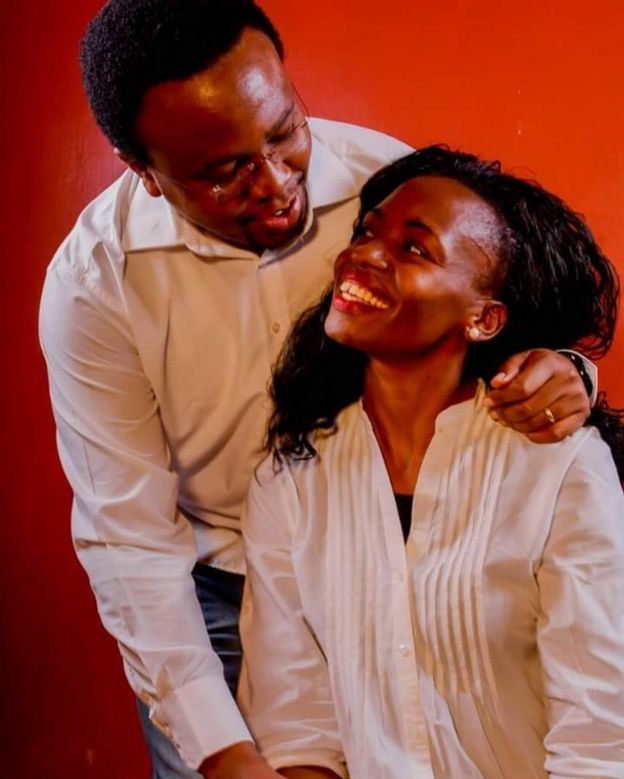 |
| *Tonny and Terry Gobanga TERRY GOBANGA |
Tonny proposed marriage but I told him to buy a magazine, read my story and tell me if he still loved me. He came back and said he still wanted to marry me.
But I said: "Listen, there's another thing - I can't have children, so I cannot get married to you."
"Children are a gift from God," he said. "If we get them, Amen. If not, I will have more time to love you."
I thought: "Wow, what a line!" So I said Yes.
Tonny went home to tell his parents, who were very excited, until they heard my story. "You can't marry her - she is cursed," they said. My father-in-law refused to attend the wedding, but we went ahead anyway. We had 800 guests - many came out of curiosity.
It was three years after my first wedding, and I was very scared. When we were exchanging vows, I thought: "Here I am again Father, please don't let him die." As the congregation prayed for us I cried uncontrollably.
A year into our marriage, I felt unwell and went to the doctor - and to my great surprise he told me that I was pregnant.
 TERRY GOBANGA
TERRY GOBANGA
Today, I am the best of friends with my father-in-law.
I wrote a book, Crawling out of Darkness, about my ordeal, to give people hope of rising again. I also started an organisation called Kara Olmurani. We work with rape survivors, as I call them - not rape victims. We offer counselling and support. We are looking to start a halfway house for them where they can come and find their footing before going back to face the world.
I have forgiven my attackers. It wasn't easy but I realised I was getting a raw deal by being upset with people who probably don't care. My faith also encourages me to forgive and not repay evil with evil but with good.
The most important thing is to mourn. Go through every step of it. Get upset until you are willing to do something about your situation. You have to keep moving, crawl if you have to. But move towards your destiny because it's waiting, and you have to go and get it.
Culled from BBC.com
Journalists Face Extinction In Mexico
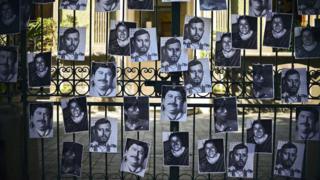 |
| *More than 100 journalists have been killed in Mexico since 2000, rights groups say AFP |
The rate at which Journalists are being killed in Mexico, they will sooner go out of existence than expected if nothing is done to check the grave calamity facing the practitioners of the pen profession.
Seven are said to have been murdered in Mexico this year alone, according to a report carried by BBC.
Seven are said to have been murdered in Mexico this year alone, according to a report carried by BBC.
One was killed while resting in a hammock at a carwash. A second was dragged from his car and shot dead near the newspaper he had co-founded. When another was killed in front of her son, the criminals left a note: "For your long tongue".
Journalists are being murdered in Mexico and this is nothing new. This is one of the most dangerous countries for reporters, rights groups say, and more die here than in any other nation at peace.
But even for a place so used to drugs-related violence and organised crime, the recent bloodshed has been shocking.
Seven journalists have been killed in the country so far this year, most shot by gunmen in broad daylight. Yet virtually all cases of attacks on the press end up unsolved and, in many, corrupt officials are suspected of partnering with criminals.
As the killings mount, is there anything that Mexico can do to save its journalists?
'A network of evil'
Miroslava Breach used to say that corrupt politicians were more dangerous than drug traffickers. For almost 30 years, she investigated cases in which authorities and criminals appeared to work hand in hand in her native state of Chihuahua, in northern Mexico.
Last year, Miros, as friends called her, reported for the national newspaper La Jornada on the alleged links between organised crime and candidates standing in the local elections in several towns in western Chihuahua - some located on lucrative drug-trafficking routes.
For her enemies, she had crossed a line.
 |
| *Drug-related violence has claimed the lives of thousands of people in Mexico GETTY IMAGES |
"Sister, now I'm really scared," her sister Rosy recalled a tearful Breach saying, as threats had increased and regularly mentioned her children. Breach alerted the authorities but carried on, not knowing what else to do.
"She said that against a network of evil there was nothing that could be done," Rosy said.
Then last March, as Breach left home in the morning to take her 14-year-old son to school, gunmen shot her eight times. They left a note, reportedly carrying the initials of one of the bandits she had denounced and a message: "Por lengua larga," meaning for your long tongue.
Since 2000, at least 106 journalists have been killed across Mexico, according to rights group Article 19. Exact numbers are hard to come by as investigations often get nowhere and different studies apply different criteria in counting the dead.
Last year alone, there were 11 deaths, the group said, a record.
Up until now, most of those killed worked for small, poorly resourced local publications. So when Breach, a reporter for a national newspaper, was killed, it resonated throughout the country, her smiling photo becoming one of the many symbols of this tragedy.
" It's an attack on our society,
not only on journalists
Oscar Murguía, editor of Norte newspaper
For Oscar Murguía, editor of Norte newspaper in the northern city of Ciudad Juárez, which published Breach's column, it was too much. His reaction was to shut the paper, after 27 years. Its last headline was a single sentence: "¡Adiós!".
"It's a tragedy," Mr Murguía told the BBC. "It's an attack on our society, not only on journalists... There's no respect for the work of journalists. I prefer to have a journalist without a job than without life."
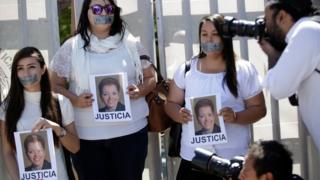 |
REUTERS
*Journalists hold placards demanding "Justice": activists say that impunity fuels the violence against the media in Mexico |
In 2010, pressure from campaigners led to the creation of a special office of the federal prosecutor for crimes against freedom of expression, known as the Feadle, which investigates attacks on journalists.
But the authorities have often ruled that the victims themselves are not journalists or that the incidents have no connection to their work, according to critics.
Like last month. When the charred remains of Salvador Adame, the head of a TV station in the western state of Michoacán, were found, state prosecutors said that the case had to do with personal disputes, possibly a love affair, angering relatives and campaigners.
The office rejected numerous requests for comment.
 |
| *Several Mexican cities are among the most violent in world, largely due to the drug war GETTY IMAGES |
The deaths continued. Then, in 2012 the federal government set up a specific protection mechanism for journalists and human rights defenders under threat.
More than 600 people have been helped by the programme, which can relocate professionals and their families, give them police protection and a panic button, which sends a distress signal to officials via cell phone networks.
Welcomed at first, many now say that very little has really worked.
The flaws were many, a report in 2015 said. They went from the unreliability of the emergency devices in areas where mobile coverage was poor, to complaints of calls to hotlines going unanswered.
The government disputed this, saying in a statement to the BBC that "achievements" have translated into "tangible benefits" for those assisted.
But last year, for the first time, a reporter under protection was killed - in front of his own house.
'Let them kill us all'
Award-winning journalist Javier Valdez was Breach's colleague at La Jornada, as a correspondent in the western Sinaloa state, home to the powerful cartel once led by Joaquín "El Chapo" Guzmán.
"Let them kill us all, if that is the death sentence for reporting this hell," was Valdez's reaction to her murder.
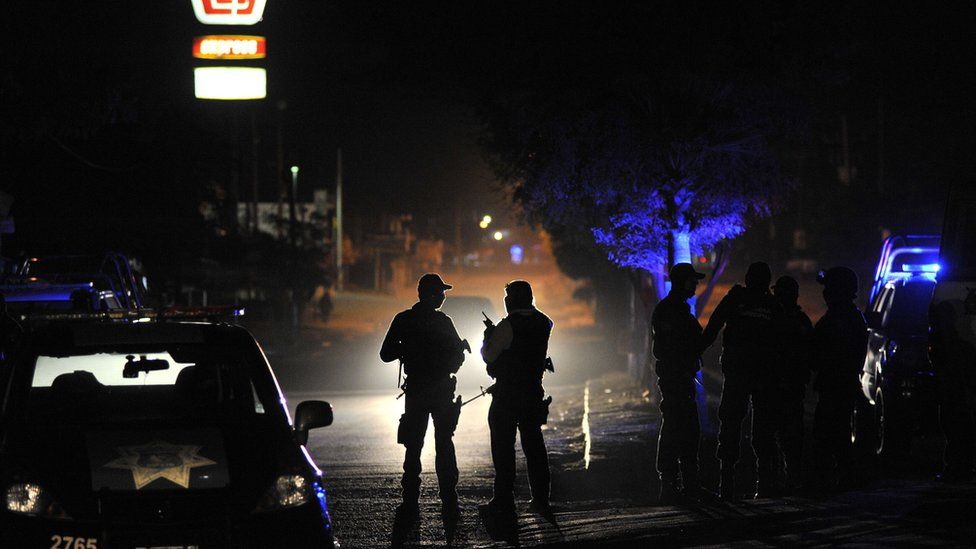 |
| *Violence in Sinaloa state spiked after the extradition of "El Chapo" GETTY IMAGES |
His was another life devoted to exposing the workings of bandits. Three decades of reporting on crime and access to drug lords had made him a star reporter, beloved by colleagues, in Mexico and further afield, who admired his clarity and good humour.
It was a work not without risks.
The offices of Río Doce, the independent weekly newspaper he co-founded in the capital Culiacán, were attacked in 2009 after it published a series on drug trafficking.
"They wanted to scare us, make us afraid so we would stop publishing," Valdez told the Committee to Protect Journalists (CPJ) in 2011, when he was given an International Press Freedom Award.
Still, he vowed to carry on. "To die," he said, "would be to stop writing."
 |
| *Javier Valdez - seen here in trademark Panama hat - was threatened for months AFP |
Violence in Sinaloa spiked after El Chapo was extradited to the United States, in January. Valdez attributed this to a vacuum of power at the top of the group.
In February, Río Doce published an interview with an envoy of "El Licenciado", who was seen as El Chapo's possible successor. Armed men bought every issue, activists said, and Valdez saw it as an attempt to intimidate him. (El Licenciado was arrested in May.)
What came next were months of threats. Then in May, Valdez, wearing his trademark Panama hat, was dragged from his car by criminals at midday, on a busy street near the Río Doce offices. They shot 12 times, killing him on the spot.
No other murdered journalist had as high profile as him. Many saw it as a message: if he can be killed, anyone can.
journalism in Mexico
"Of course we knew the risks," said Ismael Bojorquez, a long-time friend who co-founded Río Doce with Valdez. "[But] every time we felt under threat, we never thought of asking for the protection of the mechanism."
"The [Feadle] doesn't have resources or teams to investigate. Our system of protection of journalists doesn't work... The government's policies to protect us are a failure."
The result is that journalism itself has become a victim. "Investigative journalism in many places in Mexico is just impossible to be exercised," said Carlos Luria, CPJ's senior programme co-ordinator for the Americas.
"There are no guarantees, no condition, no protection, there is an absence of the state. This is decimating journalism in Mexico."
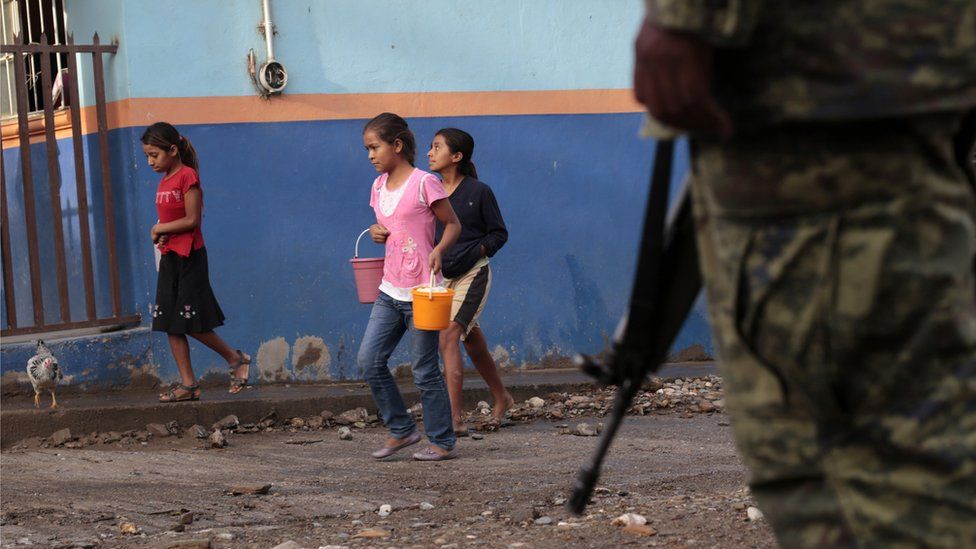 |
| *Most of the reporters killed covered crime and corruption for local publications in violent states GETTY IMAGES |
Corruption is rife in Mexico, and rogue police and politicians were the suspects in more than half of the incidents against the media in the last six years, she said. And most cases were never looked into.
"The state doesn't investigate itself. There is a direct link between the level of impunity and corruption," Ms Ruelas said. "This impunity allows the aggressors to continue attacking the press in broad daylight."
'The state is killing us'
At the National Palace in May, reporters interrupted President Enrique Peña Nieto's minute of silence in memory of the journalists killed, shouting: "Justice, no more speeches".
Valdez's death added to the pressure on Mr Nieto to address the issue. He said he shared the "indignation" and vowed to "combat the impunity", making promises to boost the protection of journalists and the special prosecutor's office.
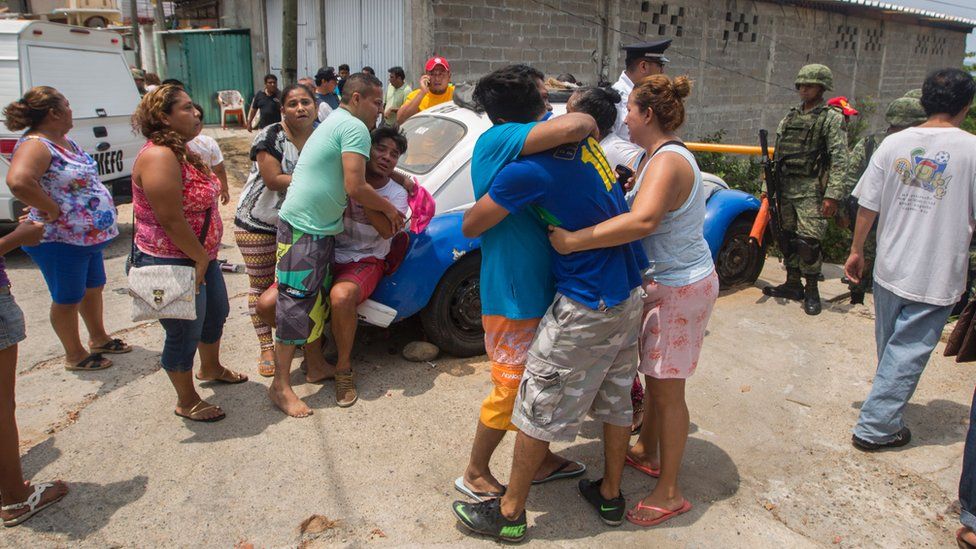 |
| *Activists say 93% of all homicides in Mexico are unsolved GETTY IMAGES |
But many hold little hope for real change.
Blanche Petrich helped found La Jornada in 1984, and knew both Breach ("the number one") and Valdez ("one of a kind"). With two of its main stars gone, the paper is now a newsroom in mourning.
"I don't have any hope," she said. "It's a myth that the cartels are killing the journalists, it's the state. I don't have any trust in Mr Nieto. He's been very indifferent to the problem."
"Nothing works if the assassins are free and those behind the killings are never brought to justice. With this reality, it's very difficult for any journalist to have any trust that those measures are not a simple formality."
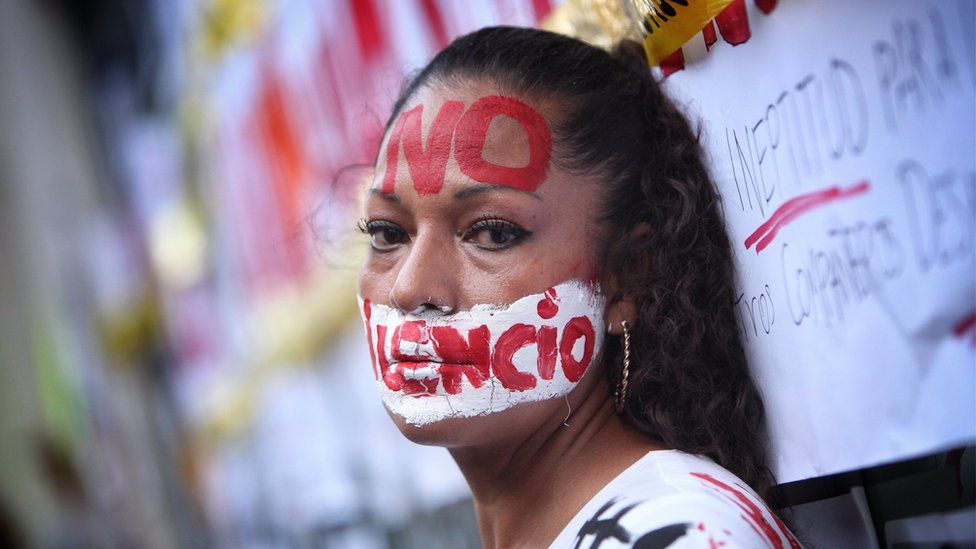 |
| *"No to silence": journalists have held protests demanding the government to investigate the killings EPA |
Distrust grew even further last month, after the New York Times accused the Mexican government of spying on several top journalists, lawyers and human rights defenders by hacking their phones with spyware meant to be used against criminals and terrorists - a claim the Mexican presidency denied.
"It's very hard to connect the words of the presidency with actions because until now we haven't found a clear reflection of these words in actions that provide results," said Ms Ruelas, from Article 19.
Reporters, however, say the latest killings prove that their work is more urgent than ever: "No to silence".
"I just picked up from somewhere that it wasn't neat enough or tidy enough and I think I wanted it to be smaller.
"People around me were watching porn and I just had this idea that it should be symmetrical and not sticking out.
"I thought that was what everyone else looked like, because I hadn't seen any normal everyday [images] before then.
"I remember thinking, 'If there's surgery for it, then clearly I'm not the only one who wants this done, and maybe it won't be that big a deal.'."
She later decided not to pursue having an operation.
"I'm totally glad I didn't get it done. I didn't need it. I look totally normal. Completely and utterly normal."
Paquita de Zulueta, a GP for more than 30 years, said it was only in the past few years that girls had started coming to her with concerns over the appearance of their labia.
"I'm seeing young girls around 11, 12, 13 thinking there's something wrong with their vulva - that they're the wrong shape, the wrong size, and really expressing almost disgust.
"Their perception is that the inner lips should be invisible, almost like a Barbie, but the reality is that there is a huge variation. It's very normal for the lips to protrude."
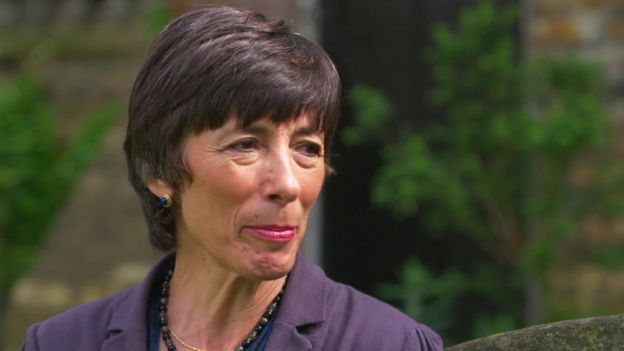
*Paquita de Zulueta says some girls magnify their physical symptoms to improve chances of having surgery
She blames the unrealistic images girls are being exposed to through pornography and social media.
"There isn't enough education and it should start really quite young, explaining that there is a range and that - just as we all look different in our faces - we all look different down there, and that's OK."
NHS England said it did not carry out the operation for cosmetic reasons, only for clinical conditions.
For the past few years clinical commissioning groups have been able to refer only patients who are experiencing physical pain or emotional distress.
But Dr De Zulueta says some girls know they need to overstate their physical symptoms to get the surgery.
"There is awareness that they're more likely to get the operation if they say it's interfering with sex, with sport, they feel that will tick that box."
'Parallels with FGM'
Dr Crouch believes labiaplasty should be given only to girls who have a medical abnormality.
"I find it very hard to believe there are 150 girls with a medical abnormality which means they needed an operation on their labia," she said.
She added there were uncomfortable parallels between this surgery and female genital mutilation (FGM), which is illegal in the UK.
"The law says we shouldn't perform these operations on developing bodies for cultural reasons. Current Western culture is to have very small lips, tucked inside. I see this as the same thing".
"There isn't enough education and it should start really quite young, explaining that there is a range and that - just as we all look different in our faces - we all look different down there, and that's OK."
NHS England said it did not carry out the operation for cosmetic reasons, only for clinical conditions.
For the past few years clinical commissioning groups have been able to refer only patients who are experiencing physical pain or emotional distress.
But Dr De Zulueta says some girls know they need to overstate their physical symptoms to get the surgery.
"There is awareness that they're more likely to get the operation if they say it's interfering with sex, with sport, they feel that will tick that box."
'Parallels with FGM'
Dr Crouch believes labiaplasty should be given only to girls who have a medical abnormality.
"I find it very hard to believe there are 150 girls with a medical abnormality which means they needed an operation on their labia," she said.
She added there were uncomfortable parallels between this surgery and female genital mutilation (FGM), which is illegal in the UK.
"The law says we shouldn't perform these operations on developing bodies for cultural reasons. Current Western culture is to have very small lips, tucked inside. I see this as the same thing".
Seeking advice
Dr Gail Busby, lead adolescent gynaecologist at St Mary's Hospital, says it is important for girls and their parents to remember:
In adolescence, the labia are still growing - with the inner lips growing first - so it is normal for them to appear prominent. Girls should not compare themselves to adult women
By age 18, the outer lips will have grown. If girls can hold off seeking an operation until adulthood, their genitals' appearance will have changed - removing the initial reason for wanting surgery
Surgery will probably lead to scarring and - as the labia are still developing - could lead to it becoming asymmetrical in adulthood
Do not feel alone. Half the girls in your class will be in the same position, it is a normal part of development - it is just that no-one talks about it openly
If parents wish to allay fears, take your daughter to a GP
In some instances, if there are deeper concerns regarding body image, it may help to create some coping strategies
The majority of labiaplasties are done by private cosmetic surgeons on women over 18.
The industry has been criticised for normalising the procedure.
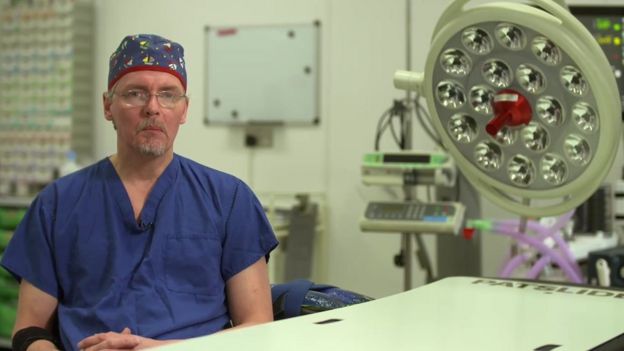 *Plastic surgeon Miles Berry says labiaplasty can improve women's self-esteem
*Plastic surgeon Miles Berry says labiaplasty can improve women's self-esteem
Plastic surgeon Miles Berry defended the surgery, saying it could improve women's lives.
"It can change people fundamentally, the feelings they have about themselves, their confidence and self-esteem.
"I have seen patients aged between 16 and 21 who have never had a boyfriend because they are so concerned about this."
The Royal College of Obstetricians and Gynaecologists said the operation should not be performed until a girl had finished developing, after the age of 18.
Dr Gail Busby, lead adolescent gynaecologist at St Mary's Hospital, says it is important for girls and their parents to remember:
In adolescence, the labia are still growing - with the inner lips growing first - so it is normal for them to appear prominent. Girls should not compare themselves to adult women
By age 18, the outer lips will have grown. If girls can hold off seeking an operation until adulthood, their genitals' appearance will have changed - removing the initial reason for wanting surgery
Surgery will probably lead to scarring and - as the labia are still developing - could lead to it becoming asymmetrical in adulthood
Do not feel alone. Half the girls in your class will be in the same position, it is a normal part of development - it is just that no-one talks about it openly
If parents wish to allay fears, take your daughter to a GP
In some instances, if there are deeper concerns regarding body image, it may help to create some coping strategies
The majority of labiaplasties are done by private cosmetic surgeons on women over 18.
The industry has been criticised for normalising the procedure.

Plastic surgeon Miles Berry defended the surgery, saying it could improve women's lives.
"It can change people fundamentally, the feelings they have about themselves, their confidence and self-esteem.
"I have seen patients aged between 16 and 21 who have never had a boyfriend because they are so concerned about this."
The Royal College of Obstetricians and Gynaecologists said the operation should not be performed until a girl had finished developing, after the age of 18.
Kids as young as ten missing school to spend 12 hours a day doing the backbreaking task in choking heat.
*Harvesting cocoa pods in the Ivory Coast is backbreaking work (Image: Adam Gerrard/Sunday Mirror)
*Harvesting cocoa pods in the Ivory Coast is backbreaking work (Image: Adam Gerrard/Sunday Mirror)
Hundreds of thousands of children are toiling in gruelling conditions to feed the world’s craving for chocolate , a Sunday People probe has revealed.
Kids as young as ten are thought to be missing out on school to work for a pittance on vast plantations harvesting cocoa pods.
They spend 12 hours a day doing the backbreaking task in choking heat for less than £2 a shift.
Some are never paid at all by unscrupulous bosses while razor-sharp machete blades and blindness-inducing pesticides are constant threats.
Others are known to have died from being worked for months on end with no holidays or even days off.
*Children like Remy, 14, are missing school to do it (Image: Adam Gerrard/Sunday Mirror)
*Amidou Yeo, 15, works with father Kregapou on a cocoa plantation (Image: Adam Gerrard/Sunday Mirror)
*Nemon Siluo, nine, works on farmland clearing vegetation (Image: Adam Gerrard/Sunday Mirror)
The use of child labour in the impoverished West African nation of Ivory Coast is fuelled by two factors.
One is the choice poor families must make between sending their children to school or out to work to bring in extra cash.
The other is the UK’s £4billion-a-year chocolate habit which sees us consume 660,000 tons annually. And that is all set against a 40 per cent drop in global cocoa prices – the industry’s biggest crisis in a decade – which is sparking fears of a rise in exploitation.
The cocoa kids are among 700,000 employed in agricultural roles, including working on rubber tree plantations.
Miranda Armstrong, Unicef’s Ivory Coast chief of child protection, said: “The root cause of child labour and child exploitation is poverty.
“Too often, parents have to make the impossible choice of sending their children to school or work. With the drop in cocoa prices, Unicef is concerned that vulnerable children will face increasing dangers.”
*Cocoa pods are harvested in their thousands (Image: Adam Gerrard/Sunday Mirror)
*The fruit inside later becomes cocoa beans (Image: Adam Gerrard/Sunday Mirror)
On a plantation near the port city of San Pedro we met Remy Compadre working for hours on end in his uncle’s farm.
Aged just 14, he has spent three months in the cocoa fields after being sent 600 miles by his own family from the neighbouring country of Burkina Faso.
From 7am until sundown each day Remy toils under the dark canopies of the cocoa trees, arduously collecting pods for his uncle on the two-hectare plantation.
The farm stands on a swathe of land in the south-west of Ivory Coast, where 30 per cent of the world’s cocoa is produced. And it belongs to a co-operative company of 1,000 farmers which supplies huge, multi-million pound wholesalers.
The company insisted that tackling child exploitation is a priority and that Remy did not “engage in hazardous or heavy work that would be classed as age-inappropriate”.
*Children are also expected to toil on rubber plantations (Image: Adam Gerrard/Sunday Mirror)
*Rubber sap drips from a rubber tree (Image: Adam Gerrard/Sunday Mirror)
The lad’s uncle Laurent Ouedraogo, 30, even claimed he had to work because he hated school.
Laurent said: “Before he left home he was working in the garden, growing tomatoes. His father said he was disrespectful. Now he refuses to go to school so he must work on the farm with me. His father has returned home.”
Remy is one of an estimated 1.4million children who officials think may be being exploited in the Ivory Coast. Our probe found they are often brought in from all over West Africa and are lucky if they get as much as £13 a week.
We also discovered they are at risk from pesticides which can rob them of their sight and cause breathing problems.
Djene Bi, a social worker at the Ivory Coast’s Ministry for Child Protection said: “Often children receive nothing. I dealt recently with two who had come from Burkina Faso and were promised 120,000 francs (£160) for a year’s work.
“They slept on the plantation, they didn’t have weekends or any holidays.
*Unicef teaches farmers how to cultivate the cocoa crop in safer ways (Image: Adam Gerrard/Sunday Mirror)
*Kaffikro in San Pedro is being supported by Unicef (Image: Adam Gerrard/Sunday Mirror)
*Many of the village's residents rely on cocoa plantations for a living (Image: Adam Gerrard/Sunday Mirror)
“But when the year had finished the owner refused to pay. This happens all the time. It’s difficult to see because some children die from over-working.”
Farmers do get regular visits from Unicef-backed organisation Anader, whose experts try to educate farmers in better safety and production techniques.
Daouda Ouattara, 36, bought his eight-hectare plantation in 1996 and has raised his four children there.
Daughter Aicha, 17, helps him strip the outer husk of the cocoa pod and pull out the white beans.
They are then wrapped in banana leaves for six days so they can ferment, to improve the flavour, baked in the sun for a week and packed in hessian bags called “jutes” containing around 100 beans each.
Aicha said: “I arrive at 6am and work 12-hour days. I work every day.”
*Social worker Djene Bi says children are sometimes paid nothing (Image: Adam Gerrard/Sunday Mirror)
*Unicef's Miranda Armstrong says the root cause of child exploitation is poverty (Image: Adam Gerrard/Sunday Mirror)
Daouda’s products are meant to be certified so wholesalers know their beans do not involve child exploitation.
But as cocoa passes up the chain from farmer to buyer, wholesaler, exporter, importer and manufacturer, it is almost impossible to trace where it was harvested.
Many big chocolate companies admit it is “difficult to guarantee” they have removed all risk of child labour on small farms in their supply chain.
More than a decade ago the industry promised a crackdown after it emerged children are being trafficked into the Ivory Coast and sold into forced labour.
Yet some sources claim the number of kids subject to child labour rocketed by 21 per cent between 2009 and 2014.
Officials say some youngsters are being ruthlessly exploited in towns.
Boys are made to burn and carry charcoal while girls work as housekeepers for less than 50p a day. Many suffer cruel punishments, with one young girl branded with a hot iron for being disobedient.
Culled from Mirror

















Comments